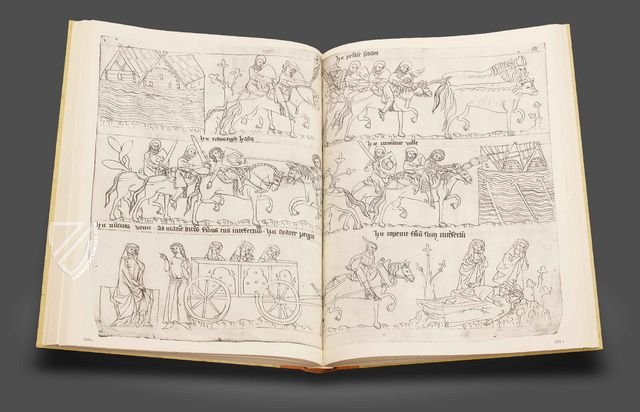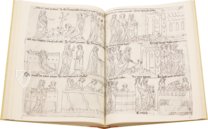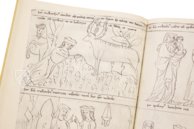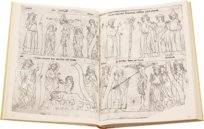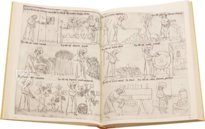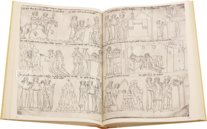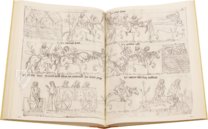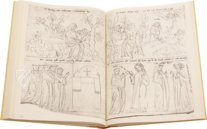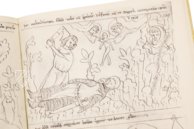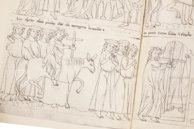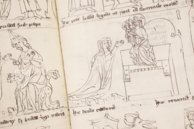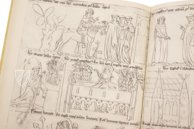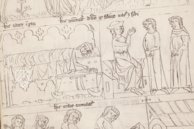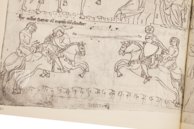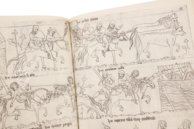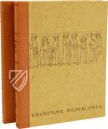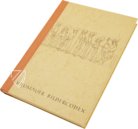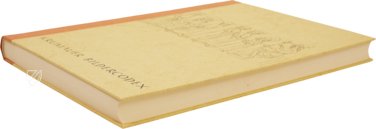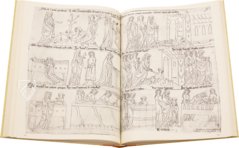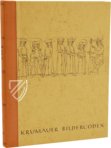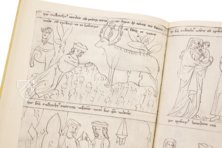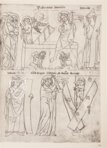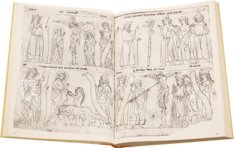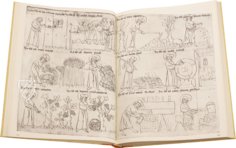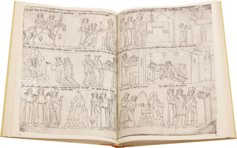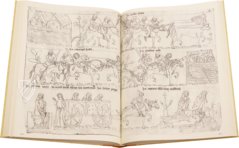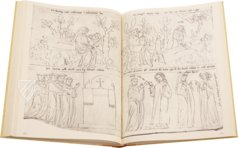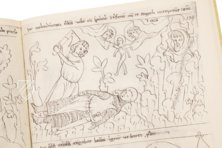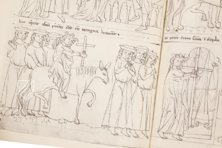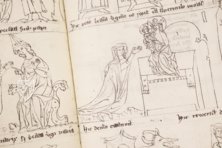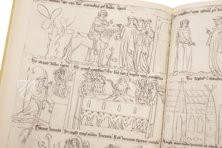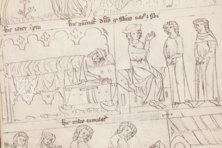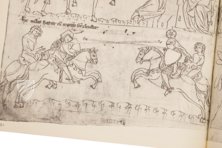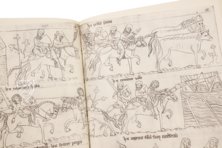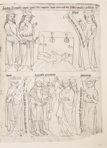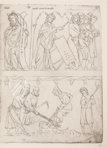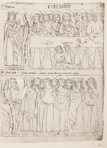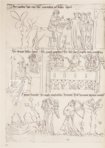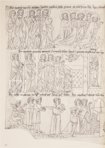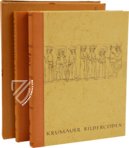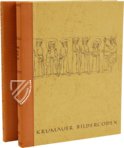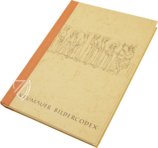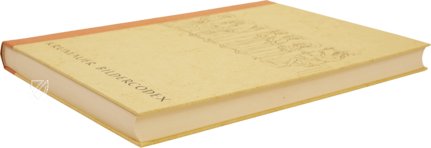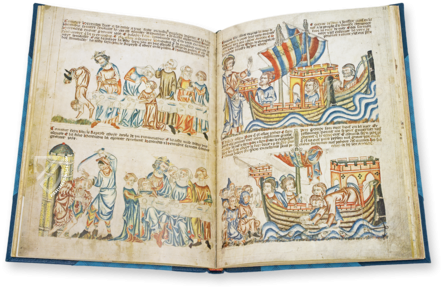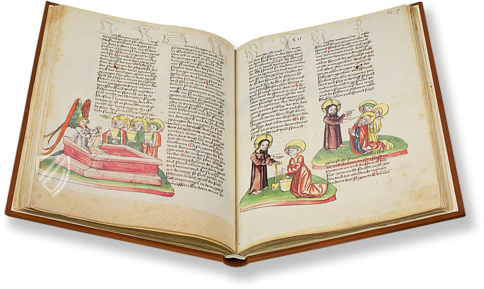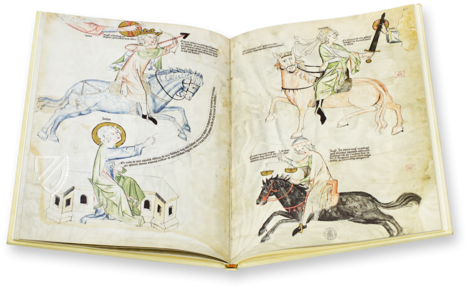Krumlov Picture Codex
(under 1,000€)
The Krumlov Picture Codex is, in many ways, a typical 14th century manuscript, both with respect to its content and its artistic character. Its subject matter consists of typological writings typical of the Late Middle Ages, such as a Biblia Pauperum, saints lives, and didactic narratives. The pictures in the Krumlov Codex are pen drawings, a technique that was widespread throughout Europe at the beginning of the 14th century, where it was mainly used for text books and scholarly manuscripts. These pen drawings were executed by three different hands which in spite of idiosyncrasies in style have created a harmonious ensemble. Favoring illustration over text, it was designed for the edification of both the lower clergy and illiterate commoners as well as wealthy noblemen and princes of the church.
Krumlov Picture Codex
The Krumlov Picture Codex is also known as liber depictus (painted book), because of its unusually rich pictorial decoration and due to an inscription on the title page. It is among the most precious manuscripts kept in the Austrian National Library, whence it came during the course of the Church reform under Joseph II which led to the dissolution of numerous monasteries. On a total of 172 parchment pages, the codex contains a Biblia Pauperum (Bible of the Poor), various lives of saints, and some narratives of a didactic character. Rather than being conceived as a scribal work to be illustrated at a later date, it was designed as a picture book whose contents are briefly explained in the picture titles. The numerous pen drawings executed by three different masters convey the religious contents in a devotional manner. The pious beholder may thus sink into the history of salvation with emphatic sensation and comprehend it rather with his heart than by reason. The Krumlov Picture Codex is probably the work of a team of artists active in the Minorite Monastery of Krumlov and was destined for use in the monastery itself. It was intended as a book of education for the lower clergy, emphasizing the picture rather than the word. This helped provide deeper satisfaction of the religious needs of this period than would have been possible with mere text.
An Edifying Picture Book
The pictures in the Krumlov Codex are pen drawings, a technique that was widespread throughout Europe at the beginning of the 14th century, where it was mainly used for text books and scholarly manuscripts. These pen drawings were executed by three different hands which in spite of idiosyncrasies in style have created a harmonious ensemble. They illustrate the narrative in all detail, in a very lively and natural manner, truly exemplifying the pictorial effect of the liber depictus. The picture sequences, arranged above each other in two or three strips, are explained in brief passages of Latin text which accompany the illustrated narrative in the form of headlines. They were written by six different individuals in gothic minuscule and rarely occupy more than one line. Occasionally, pictures contain supplementary information, such as the name of a person, and also sentences in direct speech making the involved figures speak just like in modern comic strips.
The Biblia Pauperum
The Biblia Pauperum probably goes back to the mid–13th century and belongs to the typological writings of the Late Middle Ages, which relate the entire cycle of the life and Passion of Christ. In three miniatures, scenes from the Old and the New Testament are paired, each individual miniature containing scenes from the Old Testament (types) which are framed by an episode of the New Testament (anti-types). The types of the Old Testament may be considered as a symbolic anticipation of the New Testament anti-types, whereas the latter are in turn understood as belated confirmation of the former.
An Excellent Source for Historians and Art Historians Alike
A valuable reference to the date and place of origin of the Krumlov Picture Codex is found in the three full-page miniatures. The frontispiece, with a depiction of the Virgin as apocalyptic sun bride and the depiction of the Transfiguration (fol. 156r), establishes a direct relationship to the consecration of the Minorite monastery at Krumlov, which was inaugurated in 1358 in honore corporis et Virginis Mariae. The frontispiece also marks a decisive turn in medieval religious thinking, from speculative to visionary piousness, from the abstract to the concrete. Such a vivid picture book was less bound to convey concrete information than conceptual ideas of edifying episodes. Emphasizing the picture over the written word, it was not only a piece of religious art destined for the lower, illiterate classes of the population but also meant to more deeply satisfy the religious needs of the noble and monastic circles of that period.
Codicology
- Alternative Titles
- Krumauer Bildercodex
- Size / Format
- 344 pages / 34.5 × 25.3 cm
- Origin
- Czech Republic
- Date
- Ca. 1360
- Epochs
- Style
- Language
- Patron
- Krumlov Monastery
Krumlov Picture Codex
Christ Driving the Money Changers from the Temple
A popular theme in Christian art, perhaps because it is the only episode from the Gospels in which Jesus is handing out punishment instead of receiving it, the so-called “cleansing of the Temple” is part of the narrative of all four Gospels. However, most artistic depictions, including this one, are based upon St. John’s account, the only one to specify that Jesus used a whip of chords to drive man and beast alike out of the temple while pouring out the changer’s money and overturning their tables.
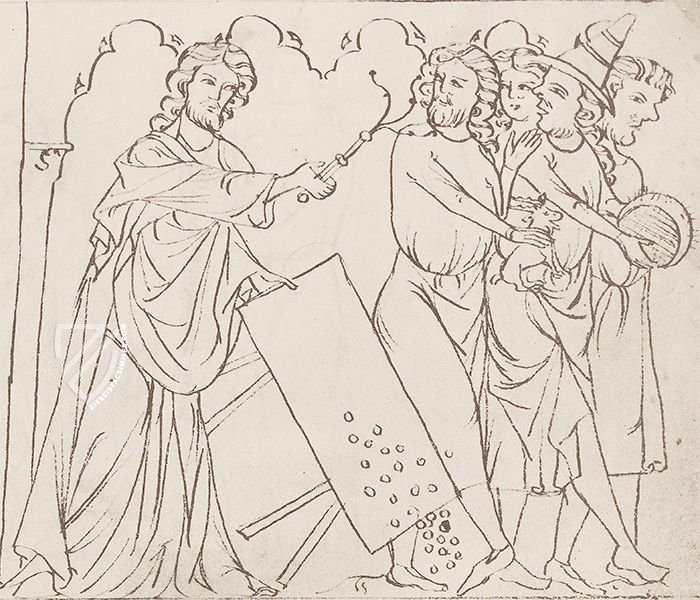
Krumlov Picture Codex
Harrowing of Hell, Resurrection, and Three Marys at the Tomb
Depicted in the lower register, the so-called Harrowing of Hell is an episode occurring after the Crucifixion in which Christ triumphantly descends to the underworld and brings salvation to the souls trapped there. He is depicted here knocking down the gates of Hell with his cross-staff and is met by a demon; both point and gesture as though debating with one another.
In the upper register, the resurrected Christ is shown emerging from his tomb and bearing the wounds of the Crucifixion, unlike in the lower register where his spirit is depicted unscathed, as the diminutive guards sleep. On the left, the Three Marys arrive at the empty tomb where they are greeted by an angel who tells them to seek Christ in Galilee.
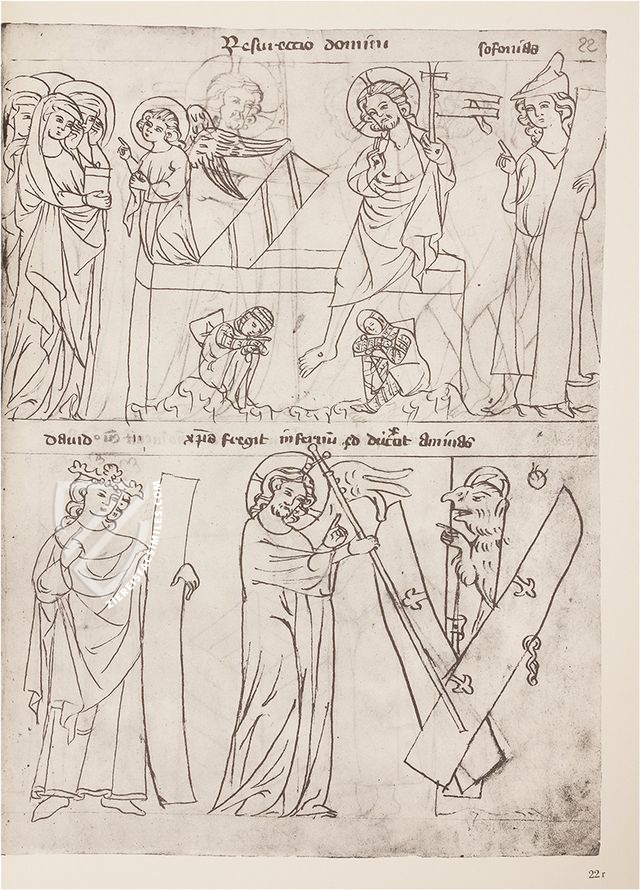
#1 Der Krumauer Bildercodex
Language: German
(under 1,000€)
- Treatises / Secular Books
- Apocalypses / Beatus
- Astronomy / Astrology
- Bestiaries
- Bibles / Gospels
- Chronicles / History / Law
- Geography / Maps
- Saints' Lives
- Islam / Oriental
- Judaism / Hebrew
- Single Leaf Collections
- Leonardo da Vinci
- Literature / Poetry
- Liturgical Manuscripts
- Medicine / Botany / Alchemy
- Music
- Mythology / Prophecies
- Psalters
- Other Religious Books
- Games / Hunting
- Private Devotion Books
- Other Genres
- Afghanistan
- Armenia
- Austria
- Belgium
- Belize
- Bosnia and Herzegovina
- China
- Colombia
- Costa Rica
- Croatia
- Cyprus
- Czech Republic
- Denmark
- Egypt
- El Salvador
- Ethiopia
- France
- Germany
- Greece
- Guatemala
- Honduras
- Hungary
- India
- Iran
- Iraq
- Israel
- Italy
- Japan
- Jordan
- Kazakhstan
- Kyrgyzstan
- Lebanon
- Liechtenstein
- Luxembourg
- Mexico
- Morocco
- Netherlands
- Palestine
- Panama
- Peru
- Poland
- Portugal
- Romania
- Russia
- Serbia
- Spain
- Sri Lanka
- Sweden
- Switzerland
- Syria
- Tajikistan
- Turkey
- Turkmenistan
- Ukraine
- United Kingdom
- United States
- Uzbekistan
- Vatican City
- A. Oosthoek, van Holkema & Warendorf
- Aboca Museum
- Ajuntament de Valencia
- Akademie Verlag
- Akademische Druck- u. Verlagsanstalt (ADEVA)
- Aldo Ausilio Editore - Bottega d’Erasmo
- Alecto Historical Editions
- Alkuin Verlag
- Almqvist & Wiksell
- Amilcare Pizzi
- Andreas & Andreas Verlagsbuchhandlung
- Archa 90
- Archiv Verlag
- Archivi Edizioni
- Arnold Verlag
- ARS
- Ars Magna
- ArtCodex
- AyN Ediciones
- Azimuth Editions
- Badenia Verlag
- Bärenreiter-Verlag
- Belser Verlag
- Belser Verlag / WK Wertkontor
- Benziger Verlag
- Bernardinum Wydawnictwo
- BiblioGemma
- Biblioteca Apostolica Vaticana (Vaticanstadt, Vaticanstadt)
- Bibliotheca Palatina Faksimile Verlag
- Bibliotheca Rara
- Boydell & Brewer
- Bramante Edizioni
- Bredius Genootschap
- Brepols Publishers
- British Library
- C. Weckesser
- Caixa Catalunya
- Canesi
- CAPSA, Ars Scriptoria
- Caratzas Brothers, Publishers
- Carus Verlag
- Casamassima Libri
- Centrum Cartographie Verlag GmbH
- Chavane Verlag
- Christian Brandstätter Verlag
- Circulo Cientifico
- Club Bibliófilo Versol
- Club du Livre
- CM Editores
- Collegium Graphicum
- Collezione Apocrifa Da Vinci
- Comissão Nacional para as Comemorações dos Descobrimentos Portugueses
- Coron Verlag
- Corvina
- CTHS
- D. S. Brewer
- Damon
- De Agostini/UTET
- De Nederlandsche Boekhandel
- De Schutter
- Deuschle & Stemmle
- Deutscher Verlag für Kunstwissenschaft
- DIAMM
- Droz
- E. Schreiber Graphische Kunstanstalten
- Ediciones Boreal
- Ediciones Grial
- Ediclube
- Edições Inapa
- Edilan
- Editalia
- Edition Deuschle
- Edition Georg Popp
- Edition Leipzig
- Edition Libri Illustri
- Editiones Reales Sitios S. L.
- Éditions de l'Oiseau Lyre
- Editions Medicina Rara
- Editorial Casariego
- Editorial Mintzoa
- Editrice Antenore
- Editrice Velar
- Edizioni Edison
- Egeria, S.L.
- Eikon Editores
- Electa
- Emery Walker Limited
- Enciclopèdia Catalana
- Eos-Verlag
- Ephesus Publishing
- Ernst Battenberg
- Eugrammia Press
- Extraordinary Editions
- Fackelverlag
- Facsimila Art & Edition
- Facsimile Editions Ltd.
- Facsimilia Art & Edition Ebert KG
- Faksimile Verlag
- Feuermann Verlag
- Folger Shakespeare Library
- Franco Cosimo Panini Editore
- Friedrich Wittig Verlag
- Fundación Hullera Vasco-Leonesa
- G. Braziller
- Gabriele Mazzotta Editore
- Gebr. Mann Verlag
- Gesellschaft für graphische Industrie
- Getty Research Institute
- Giovanni Domenico de Rossi
- Giunti Editore
- Graffiti
- Grafica European Center of Fine Arts
- Guido Pressler
- Guillermo Blazquez
- Gustav Kiepenheuer
- H. N. Abrams
- Harrassowitz
- Harvard University Press
- Helikon
- Hendrickson Publishers
- Henning Oppermann
- Herder Verlag
- Hes & De Graaf Publishers
- Hoepli
- Holbein-Verlag
- Houghton Library
- Hugo Schmidt Verlag
- Idion Verlag
- Il Bulino, edizioni d'arte
- ILte
- Imago
- Insel Verlag
- Insel-Verlag Anton Kippenberger
- Instituto de Estudios Altoaragoneses
- Instituto Nacional de Antropología e Historia
- Introligatornia Budnik Jerzy
- Istituto dell'Enciclopedia Italiana - Treccani
- Istituto Ellenico di Studi Bizantini e Postbizantini
- Istituto Geografico De Agostini
- Istituto Poligrafico e Zecca dello Stato
- Italarte Art Establishments
- Jan Thorbecke Verlag
- Johnson Reprint Corporation
- Josef Stocker
- Josef Stocker-Schmid
- Jugoslavija
- Karl W. Hiersemann
- Kasper Straube
- Kaydeda Ediciones
- Kindler Verlag / Coron Verlag
- Kodansha International Ltd.
- Konrad Kölbl Verlag
- Kurt Wolff Verlag
- La Liberia dello Stato
- La Linea Editrice
- La Meta Editore
- Lambert Schneider
- Landeskreditbank Baden-Württemberg
- Leo S. Olschki
- Les Incunables
- Liber Artis
- Library of Congress
- Libreria Musicale Italiana
- Lichtdruck
- Lito Immagine Editore
- Lumen Artis
- Lund Humphries
- M. Moleiro Editor
- Maison des Sciences de l'homme et de la société de Poitiers
- Manuscriptum
- Martinus Nijhoff
- Maruzen-Yushodo Co. Ltd.
- MASA
- Massada Publishers
- McGraw-Hill
- Metropolitan Museum of Art
- Militos
- Millennium Liber
- Müller & Schindler
- Nahar - Stavit
- Nahar and Steimatzky
- National Library of Wales
- Neri Pozza
- Nova Charta
- Oceanum Verlag
- Odeon
- Orbis Mediaevalis
- Orbis Pictus
- Österreichische Staatsdruckerei
- Oxford University Press
- Pageant Books
- Parzellers Buchverlag
- Patrimonio Ediciones
- Pattloch Verlag
- PIAF
- Pieper Verlag
- Plon-Nourrit et cie
- Poligrafiche Bolis
- Presses Universitaires de Strasbourg
- Prestel Verlag
- Princeton University Press
- Prisma Verlag
- Priuli & Verlucca, editori
- Pro Sport Verlag
- Propyläen Verlag
- Pytheas Books
- Quaternio Verlag Luzern
- Reales Sitios
- Recht-Verlag
- Reichert Verlag
- Reichsdruckerei
- Reprint Verlag
- Riehn & Reusch
- Roberto Vattori Editore
- Rosenkilde and Bagger
- Roxburghe Club
- Salerno Editrice
- Saltellus Press
- Sandoz
- Sarajevo Svjetlost
- Schöck ArtPrint Kft.
- Schulsinger Brothers
- Scolar Press
- Scrinium
- Scripta Maneant
- Scriptorium
- Shazar
- Siloé, arte y bibliofilia
- SISMEL - Edizioni del Galluzzo
- Sociedad Mexicana de Antropología
- Société des Bibliophiles & Iconophiles de Belgique
- Soncin Publishing
- Sorli Ediciones
- Stainer and Bell
- Studer
- Styria Verlag
- Sumptibus Pragopress
- Szegedi Tudomànyegyetem
- Taberna Libraria
- Tarshish Books
- Taschen
- Tempus Libri
- Testimonio Compañía Editorial
- Thames and Hudson
- The Clear Vue Publishing Partnership Limited
- The Facsimile Codex
- The Folio Society
- The Marquess of Normanby
- The Richard III and Yorkist History Trust
- Tip.Le.Co
- TouchArt
- TREC Publishing House
- TRI Publishing Co.
- Trident Editore
- Tuliba Collection
- Typis Regiae Officinae Polygraphicae
- Union Verlag Berlin
- Universidad de Granada
- University of California Press
- University of Chicago Press
- Urs Graf
- Vallecchi
- Van Wijnen
- VCH, Acta Humaniora
- VDI Verlag
- VEB Deutscher Verlag für Musik
- Verlag Anton Pustet / Andreas Verlag
- Verlag Bibliophile Drucke Josef Stocker
- Verlag der Münchner Drucke
- Verlag für Regionalgeschichte
- Verlag Styria
- Vicent Garcia Editores
- W. Turnowski Ltd.
- W. Turnowsky
- Waanders Printers
- Wiener Mechitharisten-Congregation (Wien, Österreich)
- Wissenschaftliche Buchgesellschaft
- Wissenschaftliche Verlagsgesellschaft
- Wydawnictwo Dolnoslaskie
- Xuntanza Editorial
- Zakład Narodowy
- Zollikofer AG

